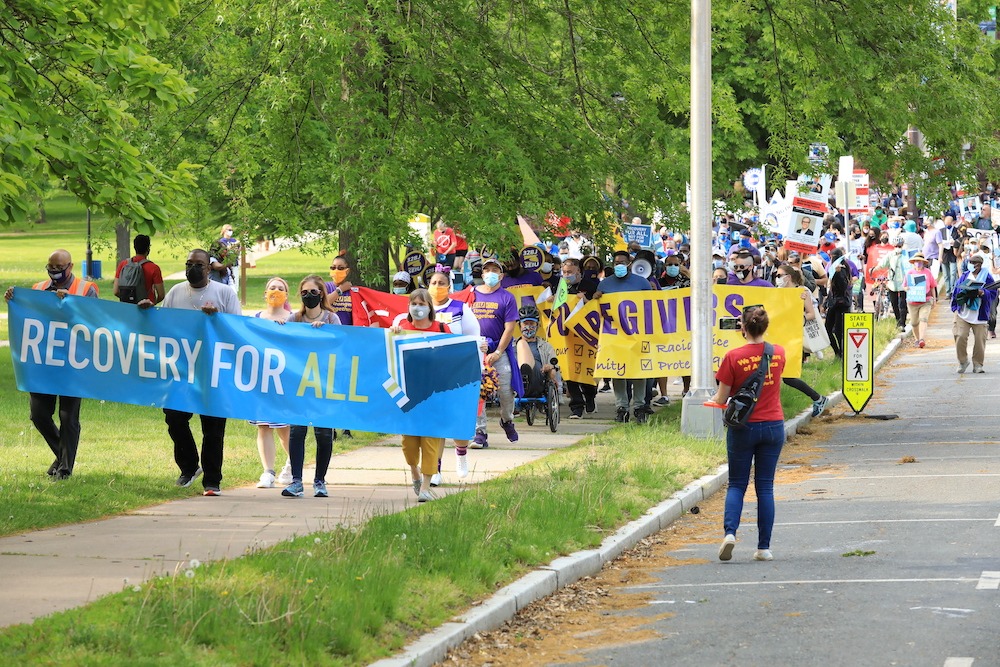
This article is the sixth installment in our series co-produced by Bargaining for the Common Good and NPQ, titled Building a Movement for the Common Good. In this series, we learn how and why Bargaining for the Common Good (BCG) is the right strategy for our times of social crisis, featuring extreme wealth inequality and declining democracy as well as a renewed attention to labor organizing and mass uprisings for racial justice. The authors tell us how community coalitions can work with unions to secure racial and economic justice today.
There isn’t one Connecticut—there are two. For those of you unfamiliar with this state, its name likely conjures images of affluent and predominantly white towns like Greenwich, Westport, and Glastonbury. But then there is the Connecticut where most residents live, struggling multiracial communities such as Norwich, Bridgeport, and Waterbury. The two Connecticuts exist side by side in adjacent zip codes, sometimes in the same zip code. A baby born in the first will probably grow up in an environment offering all the material resources necessary to pursue a healthy, happy, dignified life; a baby born in the other will probably face a life of unnecessary hardship brought on by austerity.
Connecticut thus presents a microcosm of the US’ extreme racial, economic, and gender inequalities. It consistently ranks as the wealthiest state in one of the wealthiest countries that has ever existed. Yet, the vast majority of our residents strain to make ends meet. As the crises of the 2020s widen the chasm between the two Connecticuts, a new statewide coalition called Recovery For All has formed to eliminate that chasm. Anchored by unions that practice Bargaining for the Common Good, the coalition unites 59 labor, community, faith, and nonprofit advocacy organizations in a long-term mission to shift the balance of power at the state level and enact public policy that will create a more equitable future.
Building Power Through an Inside-Outside Strategy
While the need for a coalition like Recovery For All has been evident to many local organizations for some time, the pandemic provided the impetus for its creation. Seismic developments over the last two years have intensified Connecticut’s extreme disparities, heightening urgency for united action. Consider two statistics: on the one hand, our 12 resident billionaires have seized more than a billion dollars in additional wealth apiece since the pandemic’s start. On the other hand, as a recent Oxfam report shows, almost half of all Black and Brown women in Connecticut—the very people frequently hailed as essential workers—earn poverty wages. While the state’s wealthy few prosper, working people are caught in a vise between rising costs of living and stagnant earnings.
The perilous situation that working people confront today is rooted in flawed public policy enacted long before the coronavirus pandemic began. For decades, lawmakers who formulate state budgets have at best ignored and at worst exacerbated racial, economic, and gender inequalities. In the aftermath of the Great Recession, elected officials in Connecticut responded to budget deficits by shrinking state and local services, starving nonprofits, and slashing public funding. The organizations that would come to establish Recovery For All understood that these austerity measures were the result of a manufactured fiscal crisis. To borrow an unforgettable phrase from the Chicago Teachers Union, a pioneer of Bargaining for the Common Good, we understood that the state wasn’t broke, but instead “broke on purpose.” After all, in a state of such extraordinary wealth, it was certainly possible for lawmakers to pass policies that would expand rather than erode the public resources residents need to survive and prosper. Chronic disinvestment in our communities, especially communities of color, was not inevitable or accidental—it was a political choice, based on a particular balance of power stacked against working people.
Today, in a time of social upheaval, we are reaping the consequences of that political choice. For organizations fighting for a more equitable future, the current moment has renewed determination to build the kind of strategic unity necessary to shift the balance of power and win state budgets that will transform the lives of working people. These organizations have been accustomed to operating in silos, each seeking to win its priorities on its own. Now they are hungrier than ever to build a durable coalition. Instead of short-term alliances, Recovery For All seeks to build long-term alignment; instead of compartmentalizing or neglecting fights for racial, economic, and gender justice, we embrace all as intertwined and indispensable; instead of relying on lobbying and other traditional forms of advocacy, we believe that exerting our power through mass action is the only pathway to progress.
Representing hundreds of thousands of people from all walks of life, the diverse organizations that comprise Recovery For All share not only outrage with the state’s extreme disparities, but also a positive vision of the common good. All seek to win dramatic investments in education, health care, housing, and social services—the public programs and services our communities rely on but which have endured endless cuts. To fully fund these investments, the coalition is leading the push to fix the state’s regressive and unsustainable tax structure. A state government analysis published this year showed that Connecticut’s poor and working-class residents contribute a much greater share of their income in state and local taxes than billionaires and multimillionaires, while another report from the Economic Policy Institute revealed that most corporations in the state, including those with annual income greater than a billion dollars, contribute nothing or next to nothing. Closing the divide between the two Connecticuts requires bold revenue and investment measures that center the needs of working people, in particular residents who continue to face historic oppressions, including people of color, women, and immigrants.
To fight for this vision, Recovery For All deploys our people power through an inside-outside strategy. Inside the legislative arena, the coalition mobilizes hundreds of members from across our affiliated organizations to testify at public hearings and persuade their elected officials through in-district meetings. The coalition has organized a bloc of more than 40 state legislators who champion our vision, participate in our actions, and advance our bills at the state capitol. We have also organized dozens of direct actions outside in the streets, including rallies, prayer vigils, car caravans, and marches. Direct actions draw attention to the suffering that Connecticut residents are experiencing, amplify our demands, and deepen relationships across our organizations. This commitment to showing our strength in numbers in multiple arenas has begun to challenge the reign of austerity and alter the terms of debate over the state budget.
Sign up for our free newsletters
Subscribe to NPQ's newsletters to have our top stories delivered directly to your inbox.
By signing up, you agree to our privacy policy and terms of use, and to receive messages from NPQ and our partners.
Bargaining for the Common Good Leads the Way
While Recovery For All advances our vision in the legislature and the streets, affiliated organizations do so at the bargaining table. One of the coalition’s key strengths are its unions, which are committed to and leading Bargaining for the Common Good. The model of such leadership is SEIU 1199 New England, a union representing nearly 30,000 healthcare workers employed in nursing homes, hospitals, home care, group homes, and state agencies across Connecticut. Overwhelmingly women and disproportionately Black and Brown, these care workers have put their bodies on the line to keep society afloat. During the pandemic, thousands of members got sick, 22 ended up losing their lives, and some lost loved ones after bringing Covid-19 home from work.
Over the last two years, SEIU 1199 New England has shown how Bargaining for the Common Good works by practicing an innovative form of sectoral bargaining, or bargaining that covers working conditions for most workers in an industry. Rather than negotiate contracts one by one, the union negotiated all at the same time, enabling as many members as possible to make unified demands for higher quality of care across the industry. The union partnered with community, faith, and nonprofit advocacy organizations under the umbrella of Recovery For All to formulate common good demands that center racial and gender justice and expand the scope of bargaining beyond wages, benefits, and working conditions. Finally, members of SEIU 1199 New England were unafraid to go on offense—threatening strikes, participating in nonviolent civil disobedience, and taking other forms of direct action that employers and lawmakers could not ignore.
The gains achieved through this strategy have proven historic. Members who work in private-sector long-term care facilities secured a living wage plus new measures to build racial equity at the workplace. Meanwhile, members employed in public-sector state agencies worked with allies in Recovery For All to demand the protection and expansion of state healthcare services in underserved communities. Under the banner “Expand Services to Save Lives,” they have started to notch victories, like winning more comprehensive mobile crisis services in communities of color in order to guarantee that trained health care professionals, and not police officers, respond to mental health emergencies. The fight that SEIU 1199 New England has led for expanded investment in the state’s health care infrastructure across the public and private sectors is directly linked to Recovery For All’s broader program and strategy—demonstrating how Bargaining for the Common Good can elevate efforts to enact progressive public policy at the state level.
The Promise of Statewide Coalitions
Although Recovery For All has existed for little more than a year and a half, we already have a series of impressive wins. In addition to investment in the health care sector, the coalition has helped win pandemic pay for essential workers; more aid to municipalities and nonprofits; increased funding for public education in preK-12 schools, colleges, and universities; and the extension of public healthcare to cover undocumented children. On the revenue side of the budget equation, the coalition has helped to win policies that support working families, such as a new state-level child tax credit and an expansion of the Earned Income Tax Credit, as well as changes that make the tax structure more transparent. And earlier this year, Recovery For All was pivotal to winning a reform requiring the governor justify future budget proposals based on how they will mitigate racial, economic, and gender disparities.
The story in Connecticut offers one example of statewide coalitions that have recently blossomed across the country to combat extreme inequalities. Last year, the Invest in Our New York coalition won a budget requiring ultra-wealthy residents and corporations to contribute more to fund the common good, a breakthrough that raised more than $4 billion in new revenue to support public schools, rental assistance, and more. Meanwhile, the Raise Up Massachusetts coalition is hoping to win a ballot proposition that will create a millionaire’s tax to fund public education and public transportation. This work is not confined to the Northeast; similar coalitions are emerging everywhere from the Deep South to the Pacific Northwest.
These efforts bode a promising future for statewide coalitions in the years to come—particularly coalitions anchored by unions committed to Bargaining for the Common Good. Today, we face a crisis that threatens to exacerbate our country’s morally unconscionable inequalities. Yet, in every crisis lies the opportunity for collective resistance. By forging labor, community, faith, and nonprofit advocacy organizations into a whole greater than the sum of its parts, statewide coalitions like Recovery For All offer a roadmap to winning racial, economic, and gender justice for our struggling communities.









